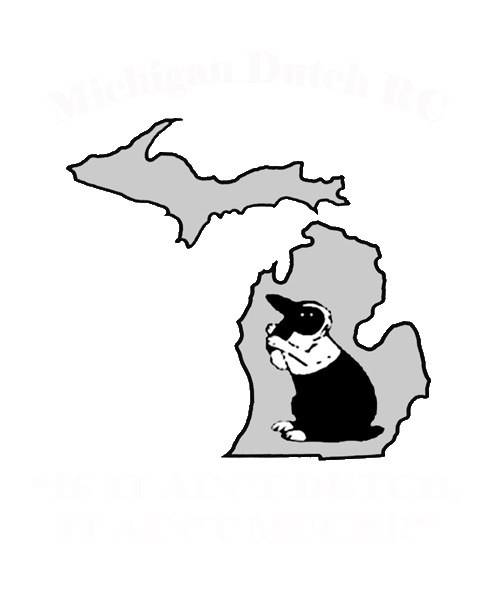
Case of the Changlings in the Nestbox
by Julie Hume
It was a dark and stormy night…Well, actually it wasn’t, but that is the way Snoopy always starts his epics. It was December 31st, and we were anxiously awaiting the birth of a gray litter from a maiden doe. The doe had a very successful show career, including best junior gray doe at the 2005 Dutch Nationals and a best in four class. So we had high hopes for her babies. When I did chores that morning, I was pleased to see that there was a lovely nest and checking inside, five babies. I briefly felt around to make sure there were no dead kits and then left mom and the babies alone. Later that day my stepdaughter, Kristy Hume, went out to check on them. When she came back in the house, she said “good news, bad news”. The good news is that all five babies are well marked. The bad news is that two of them are blue. With our vast experience with gray babies (this was our second litter), we knew the babies when born look almost black and start changing colors within a few days. These two were definitely blue. None of the babies showed an undercut, which is normal for gray. So I didn’t think we could have a blue steel, as steel have an undercut. Both the buck and doe had been purchased, but we always check background colors. We pulled the pedigree book just to make sure we had not overlooked a ringer with odd color. The buck shows all gray through three generations and the doe shows all gray except one steel great grand mother. So I started checking with a few people I know who breed gray to find out what we had and how we got them. The information we got was that a strange color can pop up now and then from something so far back in the pedigree, it does show up on the papers. Another person said we must have a blue gray, though it was not a color seen before in their experience. Within a few days the gray babies started changing, their eyes and ears were turning light and their coats turning gray. The blue babies…still looked blue. A few days later, one could see a slight lightening around the eyes and ears, and about seven days their coat started looking mealy. At this point I got on the Internet and started searching for information about odd colored grays. I came across a rabbit forum in Great Britain that is very active and had a lot of information. One of the topics listed was breeding and genetics, so I posted my query about blue-grays. Wow, did I find out a lot of information about Dutch and showing in foreign countries. In Great Britain, Dutch are shown in the following colors: black, blue, steel gray, pale gray (rarely seen) brown gray, tortoiseshell, chocolate and yellow. Depending on the number of Dutch that show, the varieties can be combined into B/B (black and blue), S/G (steel and gray), and AOC (any other standardized color). Under British Rabbit Council rules no rabbit can be shown until it is 12 weeks old, although a further complication occurs because any rabbit with a 'current year' ring on it cannot be shown until April 1st. (Britain and Australia do not tattoo the ear in the rabbit, they put a ring with a tag on the hind leg, and only the breeder can ring the rabbit.) Breed classes are divided into adults and under 4 months. However, the result in a previous ballot of UK Dutch members voted in favor of raising the age limit of young Dutch shown to 5 months. And especially interesting is their point standard: Ears....………………………....10 points
As for Eastern Australia, they offer two classes for Dutch; Self and AOC, but they only accept black, blue, chocolate, lilac, agouti, yellow, tort and steel. The tri colored Dutch have a different standard, so they are not shown with the normal Dutch. Well, you say, very interesting, but what about the odd-colored grays? When I posted the picture of them at 10 days old the consensus of the forum members was that the rabbits are opal, or, less likely, lynx. An opal has the following characteristics: top colour pale shade of blue with a fawn between this and a slate blue under colour, ears laced blue, eye circles, underside of tail and belly to be white with slate under colour, eye colour to match coat. A lynx has the following characteristics: Lilac Agouti, top color to be lilac ticked with fawn, intermediate colour to be orange, clearly defined on a white under colour, belly and underside of tail white - blue under color allowed and should not have bluish tinge on top color, eye color to match coat. Now that they are one month old (when I had to submit the article), we still don’t know what color they are. They have an Agouti ring pattern, with a blue under color tipped with tan, probably an opal. Respectably submitted, |